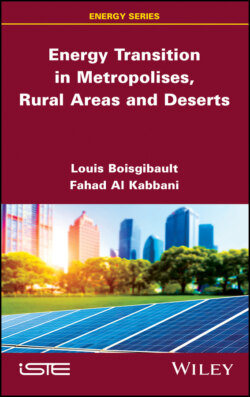Читать книгу Energy Transition in Metropolises, Rural Areas, and Deserts - Louis Boisgibault - Страница 15
1.2. Presentation of the six research areas Box 1.1. Characteristics of the six research areas
ОглавлениеMetropolises: High population density per square kilometer
– Riyadh, capital of the Kingdom of Saudi Arabia:- Member State of the Gulf Cooperation Council, the Arab League, the Organization of Petroleum Exporting Countries;- Continent: Asia, Middle East.
– Lille, capital of the Hauts-de-France region, French Republic:- Member State of the European Union;- Continent: Western Europe.
Rurality: Low population density per square kilometer
– The Pays de Fayence, a community of communes in the Var department, Provence-Alpes-Côte d’Azur region, French Republic:- Member State of the European Union;- Continent: Western Europe.
– Bokhol, rural commune in the Department of Dagana, Saint-Louis region, Republic of Senegal:- Member State of the African Union, the Economic Community of West African States (ECOWAS) and the West African Economic and Monetary Union (UEMOA);- Continent: Sub-Saharan Africa.
Desert: Lack of population
– Ouarzazate, capital of the eponymous province, Kingdom of Morocco:- Member State of the African Union and the Arab League;- Continent: Africa, Sahara Desert, Maghreb.
– Neom, a futuristic border project in the northwestern Arabian desert, Kingdom of Saudi Arabia:- Member State of the Gulf Cooperation Council, the Arab League, the Organization of Petroleum Exporting Countries;- Continent: Asia, Middle East.
As Professor Jean Girardon (2018) explained in the preface, the terrains fit together well, like a puzzle, to form a virtuous triangle of Europe, Middle East, Africa (EMEA) instead of an initial vertical line of Europe, the Mediterranean, Africa (Boisgibault 2016b) and Saudi Arabia studied in isolation (Al Kabbani 2017). One could ask oneself at the outset why have only these six territories been selected and not 10 or 20 others that are complementary, selected with quantitative criteria? First of all, it should be recalled that this is the disciplinary field of the human and social sciences and not the hard sciences, which are very much involved in energy issues. Qualitative methods, i.e. interpretative methods without figures, are recognized. Then, these fields were validated by the respective thesis juries because they are very instructive. The study in detail and in the duration of local action as well as pragmatism were favored. The data collected are important and choices had to be made to present the best summary here.
As for the methodology, it was based on a literature review, study tours, field surveys, interviews with managers, mapping analyses, collection and processing of statistical data, participation in conferences during the period 2011 to 2016, and then updating all its data to present the most up-to-date results in 2019. The three types of spaces – metropolitan, rural and desert – have emerged, requiring choices to be made on the land presented and the methodology to be adapted in a pragmatic way. That is precisely the heart of the matter. In metropolitan areas, access is easy by plane, train and car and appointments can easily follow one another with decision-makers and university colleagues. In rural areas, access is more difficult because it is necessary to change means of transport to get to the final destination, most often by road, and there are fewer people to talk to. Finally, in the desert, we can talk about real expeditions where there are no more key players on the spot.
What about the Americas, the Far East, Oceania, Antarctica and the Southern Hemisphere? Despite not wanting to exclude particular territories from the energy transition, choices had to be made for reasons of time and budget. Europe, the Middle East and Africa are already a good place to start research.
Figure 1.1. Maps of research fields1
Table 1.2. Geographical coordinates of the six study sites, from north to south
| Latitude | Longitude | Altitude (m) | |
| Greenwich Meridian | 0° | 0 | |
| European metropolis of Lille | 50° 37' N | 3° 04' E | 25 |
| Pays de Fayence | 43° 37' N | 6° 41' E | 360 |
| Ouarzazate (Sahara Desert) | 30° 55' N | 6° 54' W | 1,100 |
| Neom (Arabian Desert in Tabuk) | 29° 7' N | 35° 04' E | 0 to 2,500 |
| Riyadh | 24° 37' N | 46° 42' E | 600 |
| Tropic of Cancer | 23° 26' N | – | 0 |
| Bokhol | 16° 31' N | 15° 24' W | 10 |
By specifying the geographical coordinates of the six fields studied, this makes it possible to better visualize the location and compare these territories on the globe. The coordinates are derived from the WG 84 geodetic system (World Geodetic System 1984), which models the shape of the earth into an ellipsoid of revolution around the north-south axis, slightly flattened at the poles. Latitude has a much stronger influence on climate than longitude. Climate and its temperatures are also influenced by altitude, which directly affects people’s behavior in terms of food, heating and cooling. All the examples are in the northern hemisphere. Bokhol is the only one of the six fields to be south of the Tropic of Cancer, which is a parallel whose position varies, at 23° 26' 12.555" on January 1, 2019. Senegal and Ouarzazate are the two terrains west of the Greenwich meridian, the other four being to the east, but these longitudes have no particular influence in the analysis, except for the time difference. Since the Earth’s perimeter is about 40,000 km at the Earth’s equator and corresponds to 360° for longitude, 1º represents about 111 km at the equator, 1 minute represents 1/60th of a degree or about 1.8 km at the equator. It is an almost isosceles research triangle, with two sides of 4,700 km between Europe–Africa and Europe–Middle East, with a base of 6,400 km between West Africa and the Middle East.
